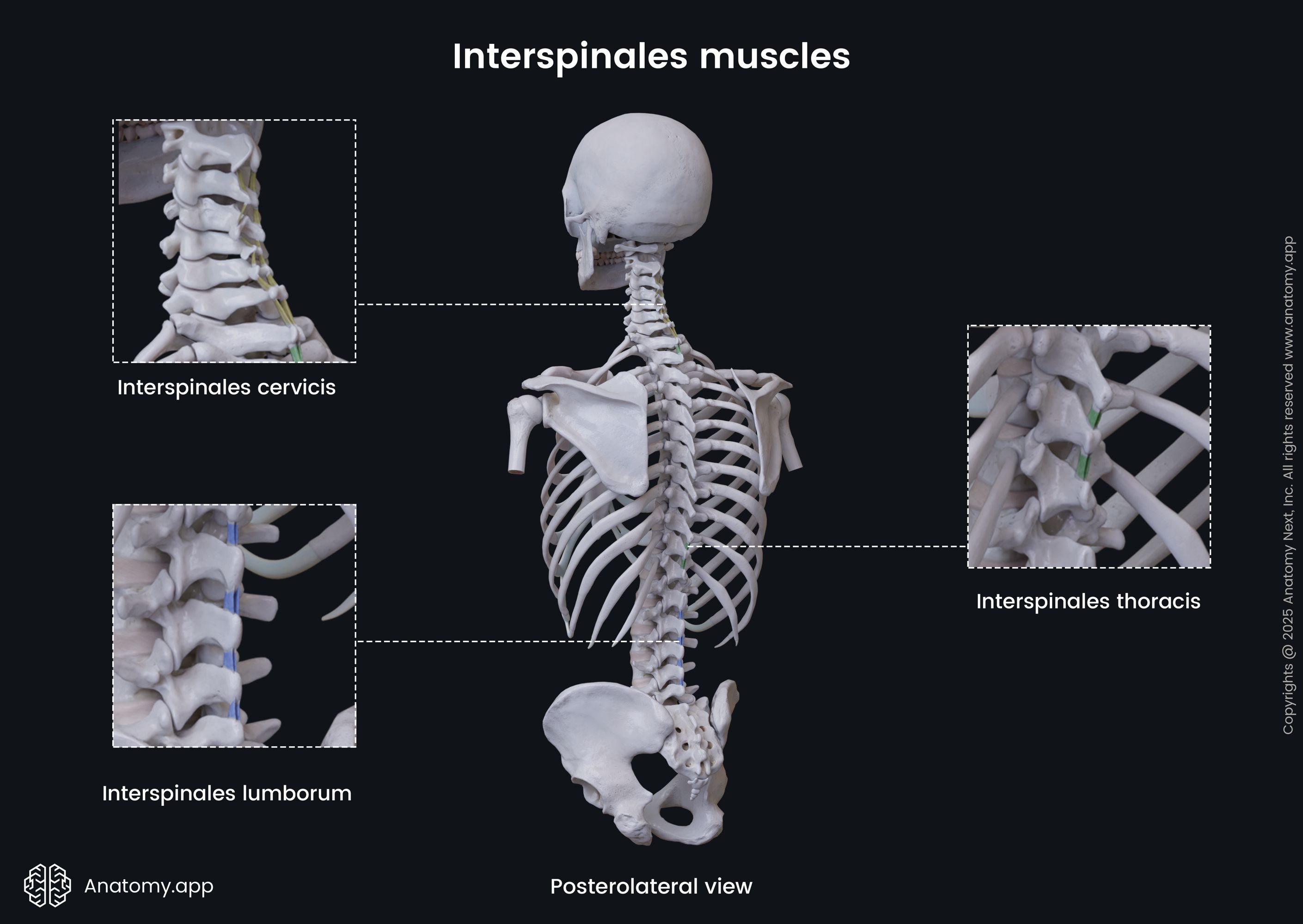- Anatomical terminology
- Skeletal system
- Joints
- Muscles
- Head muscles
- Neck muscles
- Muscles of upper limb
- Thoracic muscles
- Muscles of back
- Superficial back muscles
- Intermediate back muscles
- Deep back muscles
- Superficial layer
- Intermediate layer (Erector Spinae)
- Deep layer (Transversospinales)
- Deepest layer
- Muscles of lower limb
- Heart
- Blood vessels
- Lymphatic system
- Nervous system
- Respiratory system
- Digestive system
- Urinary system
- Female reproductive system
- Male reproductive system
- Endocrine glands
- Eye
- Ear
Interspinales
The interspinales (Latin: musculi interspinales) are short, paired deep muscles of the back that lie in the deepest layer of the group. They extend between the spinous processes of two adjacent vertebrae. The interspinales extend throughout the entire length of the spine. However, they are most developed in the cervical and lumbar regions. In the thoracic region, they are underdeveloped or often completely absent. The primary function of the interspinales muscles is to stabilize the spine during movements and maintain a body posture. They also aid other deep back muscles in extending the spine.

Interspinales cervicis
The interspinales cervicis (Latin: musculi interspinales cervicis) are paired muscles lying deep within the back of the neck, extending between the spinous processes of two adjacent cervical vertebrae.
| Interspinales cervicis | |
|---|---|
| Origin | Superior aspects of spinous processes of C3 - T1 vertebrae |
| Insertion | Inferior aspects of spinous processes of C2 - C7 vertebrae |
| Action | Extension of cervical spine, stabilization of cervical spine, maintenance of body posture |
| Innervation | Dorsal rami of cervical spinal nerves |
| Blood supply | Vertebral, deep cervical, transverse cervical and occipital arteries |
Origin
The interspinales cervicis muscles originate from the superior aspects of the spinous processes of the third cervical to first thoracic vertebrae (C3 - T1).
Insertion
The interspinales cervicis are located on either side of the interspinous ligaments. These muscles insert one level above the origin sites on the inferior aspects of the spinous processes of the second to seventh cervical vertebrae (C2 - C7), respectively.
Action
The interspinales cervicis muscles provide the extension of the cervical spine. Most importantly, these muscles stabilize the cervical spine and maintain a body posture.
Innervation
The interspinales cervicis are innervated by the dorsal rami of the cervical spinal nerves.
Blood supply
The arterial blood supply to the interspinales cervicis muscles is provided by the branches of the vertebral, deep cervical, occipital and transverse cervical arteries. The vertebral artery arises from the subclavian artery, while the occipital artery is a branch of the external carotid artery. The deep cervical artery branches off the costocervical trunk, and the transverse cervical artery originates from the thyrocervical trunk.
Interspinales thoracis
The interspinales thoracis (Latin: musculi interspinales thoracis) are deep muscles of the thoracic region of the back, extending between the spinous processes of two adjacent thoracic vertebrae. These muscles are usually underdeveloped or absent, with only some areas having distinct muscle fascicles. Typically three pairs of the interspinales thoracis muscles are only present.
| Interspinales thoracis | |
|---|---|
| Origin | Superior aspects of spinous processes of T2, T11 and T12 vertebrae |
| Insertion | Inferior aspects of spinous processes of T1, T10 and T11 vertebrae |
| Action | Aids in extension of thoracic spine |
| Innervation | Dorsal rami of thoracic spinal nerves |
| Blood supply | Superior and posterior intercostal arteries, subcostal artery |
Origin
The three pairs of the interspinales thoracis muscles arise from the superior aspects of the spinous processes of the second (T2), eleventh (T11) and twelfth thoracic vertebrae (T12). However, the origin sites of the interspinales thoracis can vary.
Insertion
Each interspinales thoracis muscle attaches to the inferior aspects of the spinous processes of the vertebra one level above the origin site. They insert on the first (T1), tenth (T10) and eleventh thoracic vertebrae (T11) accordingly to the origin sites.
Action
The interspinales thoracis are usually underdeveloped muscles, but they may aid in extending the thoracic spine.
Innervation
The interspinales thoracis are innervated by the dorsal rami of the thoracic spinal nerves.
Blood supply
These interspinales thoracis muscles are supplied by the branches of the superior and posterior intercostal arteries and subcostal artery. The superior intercostal artery arises from the costocervical trunk, while the posterior intercostal artery originates from the superior intercostal artery and thoracic aorta. And finally, the subcostal artery is also a branch of the thoracic aorta.
Interspinales lumborum
The interspinales lumborum (Latin: musculi interspinales lumborum) is a group of paired muscles located deep within the lumbar region of the back, extending between the spinous processes of two adjacent lumbar vertebrae.
| Interspinales lumborum | |
|---|---|
| Origin | Superior aspects of spinous processes of L2 - L5 vertebrae |
| Insertion | Inferior aspects of spinous processes of L1 - L4 vertebrae |
| Action | Extension of lumbar spine, stabilization of lumbar spine, maintenance of body posture |
| Innervation | Dorsal rami of lumbar spinal nerves |
| Blood supply | Lumbar arteries |
Origin
The fibers of the interspinales lumborum muscles originate from the superior aspects of the spinous processes of the second to fifth lumbar vertebrae (L2 - L5).
Insertion
The interspinales lumborum muscles insert on the inferior aspects of the spinous processes of the adjacent vertebrae one level above the origin site - on the first to fourth lumbar vertebrae (L1 - L4), accordingly.
Action
The interspinales lumborum muscles stabilize the lumbar spine and provide a body posture, and they also aid in the extension of the lumbar spine.
Innervation
The interspinales lumborum are innervated by the dorsal rami of the lumbar spinal nerves.
Blood supply
The arterial blood supply to the interspinales lumborum muscles is provided mainly by the lumbar arteries that arise from the abdominal aorta.